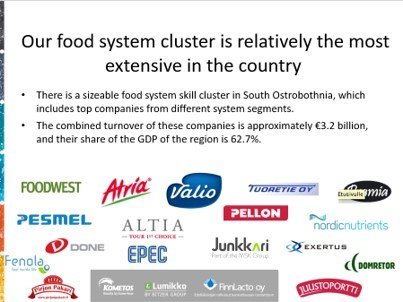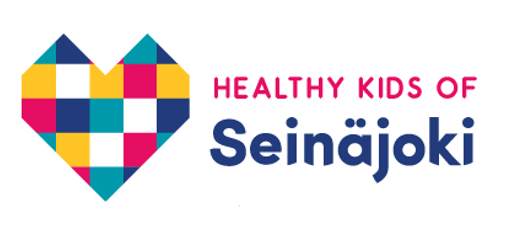Living lab description
General information about Seinäjoki living lab work
Seinäjoki living lab is focused on developing a sustainable and resilient food system of the point of view of the children and youngsters. In the Seinäjoki city region there are various development processes going on about the most seen and recognized food services such kinder garden/school food (free of charge in schools for everyone) and eating at home within a family. These Seinäjoki living lab pilot actions target the gaps in between these big well recognised actions. Pilot’s themes are little developed before, but they have a great effect to the childrens’ and youngsters' nutrition and food behaviour. The four parts of the pilot are:
- The healthy snack, piloting better snacks in sports clubs’ environment
- The Food Business club, piloting in school related youngster’s waste food related hobby business model
- Develop the school cantines into school restaurants: making the environment of the school meals better
- The Pikkuprovinssi children’s festival, piloting to make the actions more food-related + improving the children’s festival food
The pilot actions follow the idea of the quadruple Helix approach: in the pilot there are stakeholders from the public sector, research, citizens, companies and the environment is well taken into consideration in actions. The Seinäjoki Team of Cities 2030 (Including P12Into P13Agria) works tightly together in the actions. One of the team takes a lead of the action, but the others innovate, prepare and support in the background.
| Main challenge | Subchallenge #1 | Subchallenge #2 | Subchallenge #3 | Subchallenge #4 |
| Main challenge is to ensure better and healthier snacks for children during free time environments and to empower children to make the change | Sport clubs' canteens include mainly unhealthy snacks and beverages | Food sector is considered unattractive and youngsters doesn't see the sector as potential career choice | Only 65% of the Finnish junior high school students eat free warm school meals daily. There is lot of research about the actual food (quality, taste etc.), but we lack of information about the other factors (social and physical environment). | Challenge is that children lack of knowledge and appreciation how food is produced, and therefore they easily make a selection of unhealthy choices. We need to raise the knowledge and |
Recognising the paths of change
There four parts of Seinäjoki pilots are necessary and before poorly recognised development areas of children’s and youngsters’ entity of food. The needs of change are recognised by studying the children and youngsters as consumers. They make more decisions about food than is commonly understood, especially when they are outside homes obtaining snacks or choosing how to eat a school meal (partly, only when the favourite is on the menu, etc.). There is a possibility to make a difference in choosing and meal enjoying behaviour in school canteens only using the research about eating environments and its effect on the eaters. Also, the younstes can work for themselves as entrepreneurs: a ready-made system does exist but more encouragement and guidance is needed to make food business. The last niche of the children’s/youngsters’s food entity are festivals and happenings and the food consumed there: the festival food served as energy and enjoyment is one part of a child’s life, but festivals are great platforms to do food education also in other ways than only eating the food.

Organising resources and time available
The key factor to complete a well working living lab is to prioritise both the time usage and the other resources, as personnel work time and funds available to the work. This can be done by using ready-made project management tools, good communication in between the partners involved and by doing assessment work along the way.
To co-create, to co-design, to experiment: real-life testing of proposed innovative activities/Elina
All these four Living labs as system innovation initiatives include co-create, co-design and to experiment actions, as a joint development activity that includes stakeholders in its innovation. Living labs brings together stakeholders from the business community, knowledge institutions, education, research institutes and from the third sector. Stakeholders collaborate with the aim of healthier and more nutritional snacks to children and share value creation to a broader community. “Healthy Snacks” is a particularly relevant example of co-creation with the third sector, parents and children themselves. The “Food Business Club” and the development of school cantines into school restaurants orchestrates system innovation in practice with students and schools. The “Pikkuprovinssi festival” pilot aims to developing and testing as experiment new food related initial in co-design with the cultural sector.
Monitoring and learning
The focus of CRFS Labs of Seinäjoki (Finland) will be on the Healthy Kids of Seinäjoki, their nutrition and empowerment and engagement of communities and stakeholders around them. Our goal is to develop a system that supports better and better nutrition for young people and an understanding of the holistic food system. Our aim is to develop a support system that comprehensively guides young people to better consumption. The intention is to get the developed system spread to other cities as well.
Through the components of the pilot, we work with both young people and their various support groups. Continuous interaction and involvement also ensure that the voice of young people and children is heard in the evaluation and development of the pilot experiment. Following the results of the pilot experiments, we will gain valuable insight into how the work should proceed. With the help of practical close pilots, we get close to young people and their lives. With the help of support groups, we can give them information and guidance about what they need for the future.
We try to find good practices on how to guide children and young people to become responsible adults of the future. One problem is how to find the right metrics to track future developments. In evaluating the success of the pilots, we also ask the opinion of the participants.
There is a need to monitor the attitudes and work of regional and / or local policies affecting the food system. In the implementation of the work, continuous feedback between PL and LL is essential to ensure consistency between the objectives of CRFS Labs and the regional administration of the food system also in the future.
Measures
The healthy snack kiosk “Mahti-kiska
- Producing multiple short videos of the Healthy Snacks, Nutrition of kids, and instructions to establish a healthy food kiosks to events
The Food Business Club
- One hobby club for youngsters in Seinäjoki lyseo junior high school
The School Canteens into Restaurants
- More kids eat the free school lunch
- Two junior high school canteen have been "tuned up"
- Guide to tune up the school restaurant
Kids’ Culture Festival “Pikkuprovinssi” into Culture and Food Festival
- Co-operation with the labs with the theme city farming.
-
New consept in festival 5/2023


